The listening space of a hi-fi enthusiast is often crammed with retro furniture, an assortment of speakers, vinyl records, and key components like integrated amplifiers and receivers. And that’s just the analog crowd. Digital-music-loving audiophiles, on the other hand, rely on some sophisticated audio components to deliver the best-sounding digital tracks to their ears, and that's where a network music streamer comes in.
Joining the ranks of modern AV receivers and amplifiers, a network music streamer lets you stream hi-res audio tracks (and lesser formats) from a number of built-in music-streaming platforms. We’re talking about services like Tidal, Qobuz, and Apple Music, where higher-bitrate tracks are prioritized. Network music streamers make use of premium audio technology, including precision-tuned DAC (digital-to-analog converter) systems, to ensure you’ll get the best sound possible from your favorite online tracks.
With a multitude of options to vet through, we thought we’d make your hi-fi playback all the easier by handpicking the best network music streamers you can get.
 Cambridge Audio
Cambridge Audio
Cambridge Audio CXN100
Best network music streamer
Pros
- Terrific sound quality
- Intuitive and user-friendly controls
- Supports numerous top formats and streaming platforms
Cons
- Pricey
- Outperformed by a few other streamers
Cambridge Audio is no stranger to the world of premium audio devices, and the incredible CXN100 Network Audio Player is further proof that the brand shows no signs of stopping. This sleek Lunar Grey box is sized to fit alongside most AV components and has an upgraded ESS DAC for enhanced sound quality and minimized distortion. This sounds nice on paper, but the reality is even better: Crisp-clear audio with a massive soundstage. And as for hi-res streams, this bad boy supports playback at up to 32-bit/768kHz.
Whether you plan on streaming tunes via Wi-Fi, Bluetooth, USB, or through a compatible NAS device, the CXN100 accepts all the above connections and has 64GB of storage to work with, too. The interactive LCD makes it easy to keep tabs on what tracks, albums, or playlists you’re listening to, and the player has access to music streaming services like Spotify, Tidal, Deezer, and Qobuz, along with MQA, Chromecast, AirPlay, and Roon compatibility.
At $1,100, it’s one of the more expensive network music streamers on our list, but it’s hard to deny the performance and versatility that the Cambridge Audio CXN100 brings to the table.
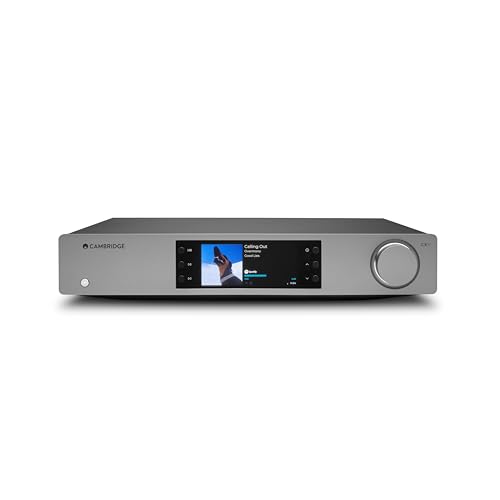
Cambridge Audio CXN100
Best network music streamer
 HiFi Rose
HiFi Rose
HiFi Rose RS250A
Great for music and music videos
Pros
- Impressive sound quality
- ESS flagship DAC
- Bountiful format support
- 8.8-inch touchscreen plays music videos
Cons
- Very expensive
- RoseConnect app need some work
you might not be familiar with South Korean hi-fi audio brand HiFi Rose, but the company brings something unique to the music streamer fray with its HiFi Rose RS250A, which pulls double duty as a powerhouse network music streamer and 4K video hub. At first glance, you might think the 8.8-inch touchscreen is just a music UI, but a simple swipe puts you into video mode, complete with 60 fps playback. But the real thrill is the inclusion of an HDMI output, which lets you connect the streamer to a TV for a bigger AV experience.
The RS250A consolidates YouTube content into the RoseTube app, a first-party player with a custom interface and the ability to link your own YouTube account for even more content. You’ll even be able to access music videos via Tidal or locally stored media with the VIDEO app. Of course, you’ll also have access to some incredible music streaming options, including Apple Music, Tidal, and Qobuz, as well as Bugs, one of South Korea's premiere streaming services.
Like any good network music streamer, sound quality is a top priority for HiFi Rose. The RS250A features rigid aluminum panels for minimized vibrations and increased ventilation, an ESS flagship DAC for top-notch audio processing, and up to 32-bit/768kHz playback support.
The Rose also features full support for MQA tracks, along with WAV, FLAC, and other leading audio formats. While its lofty price may deter some, the HiFi Rose RS250A delivers a robust streaming experience that is hard to beat.
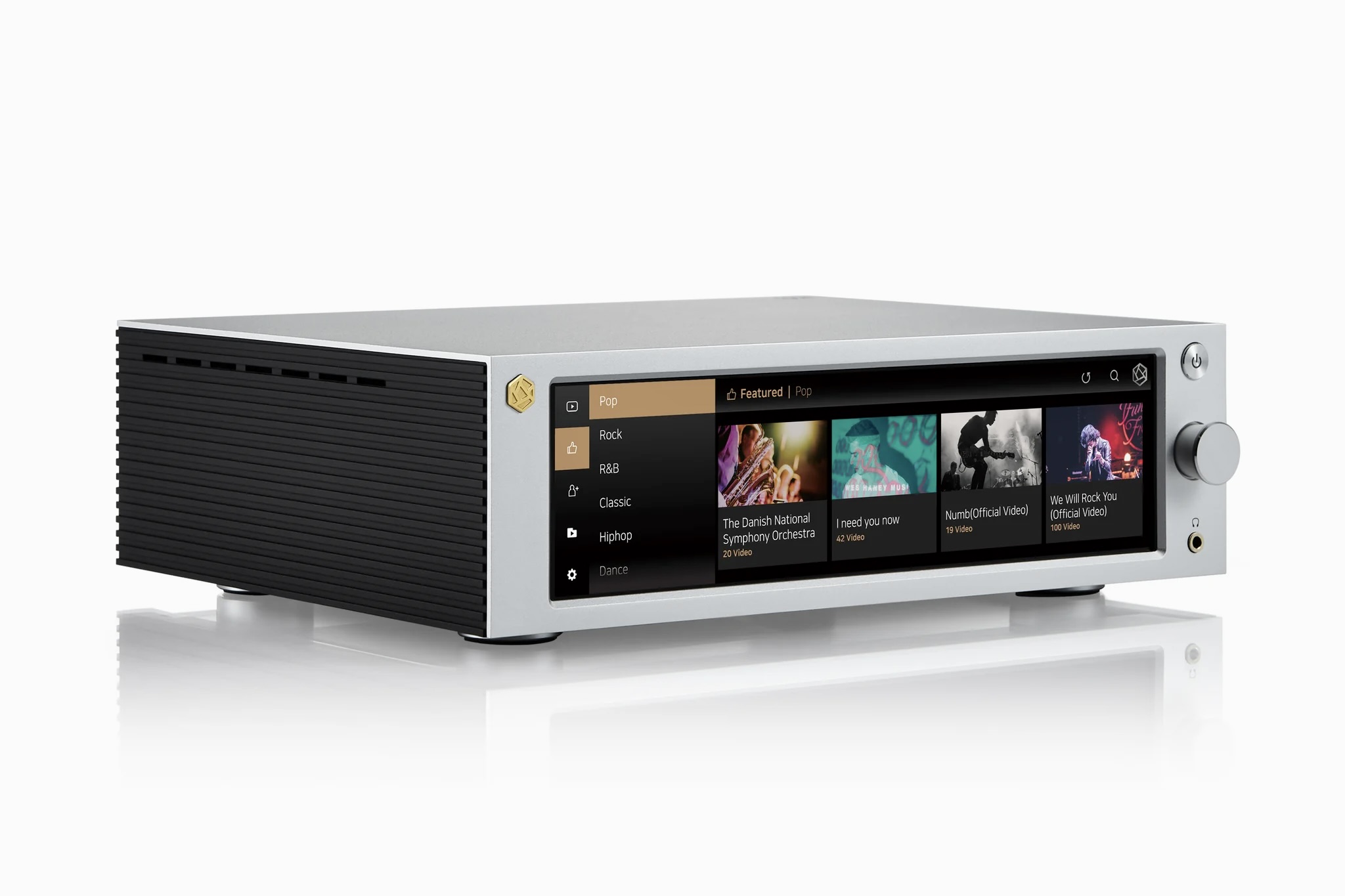
HiFi Rose RS250A
Great for music and music videos
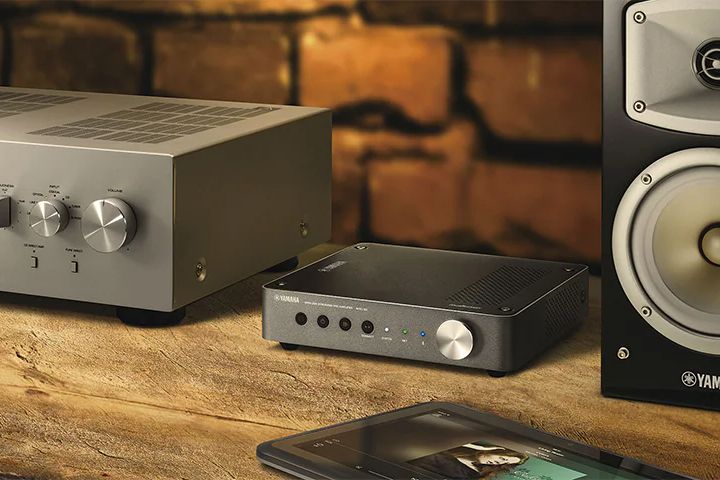 Yamaha
Yamaha
Yamaha WXC-50
Solid compact streamer with built-in preamp
Pros
- Built-in preamp
- Compact design can stand vertically
- Excellent DAC
Cons
- No native support for Apple Music, Qobuz, or Amazon Music
When it comes to overall performance, features, and value, we believe the Yamaha WXC-50 is a great mid-priced option for users looking for a network streamer that includes a built-in preamp, making it ideal for those of us who want to dedicate all our AV ins, outs, and EQ to a single device. It also has a pretty small footprint and can be mounted vertically to save even more space.
Outfitted with a ESS Sabre DAC and an onboard music enhancer for touching up your MP3s, the name of the game is precise and rich sound at a price that doesn’t frighten. You can connect to the WXC-50 using Bluetooth, Wi-Fi, or via wired Ethernet, and the device supports several popular streaming platforms, including Spotify Connect, Pandora, and SiriusXM. Sadly, there is no native support for Apple Music, Qobuz, or Amazon Music.
You’ll also be able to download the MusicCast app (for iOS and Android) to control the streamer with your smartphone or tablet, as well as link the WXC-50 to other wireless Yamaha gear for multi-room audio. Its $450 price puts it smack in midrange territory.

Yamaha WXC-50
Solid compact streamer with built-in preamp
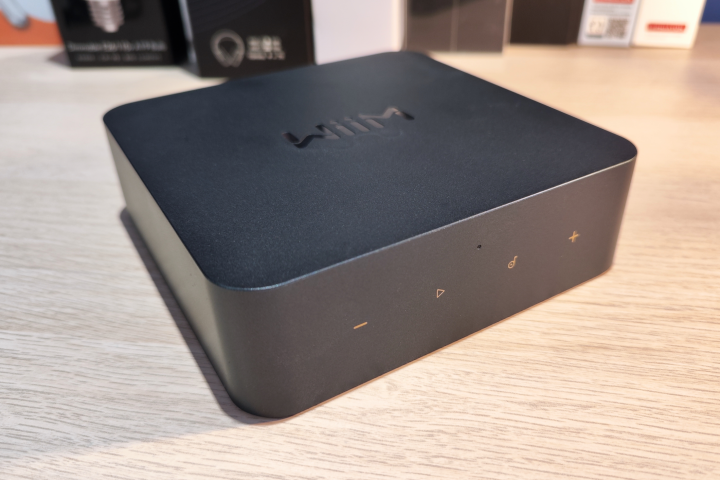 Simon Cohen / Digital Trends
Simon Cohen / Digital Trends
Wiim Pro
Best budget-friendly network music streamer
Pros
- Highly affordable
- 24-bit/192kHz lossless audio
- Excellent app design
- AirPlay/Chromecast/Bluetooth
- Strong streaming service support
- Lots of connections
Cons
- No Apple Music/YouTube Music access in the app
Our own Simon Cohen is a certified digital music aficionado, and a hard nut to crack when it comes to getting him to cop to the virtues of analog formats like vinyl (we have yet to). But he's about the most knowledgable person we know in this area, so you can trust his review of the formidable $149 Wiim Pro.
A direct competitor to Sonos' popular Port (it's kind of a carbon copy, really), the Wiim Pro is a bare-bones black box that isn't much to look at, design-wise. But don't let that fool you. Like the Sonos Port, the Wiim Pro is stacked with connection options, physical and wireless, including RCA line in and out (for connecting external sources like turntables and CD players that can then be streamed out through the system), coax, SPDIF optical in/out, LAN, Wi-Fi, AirPlay, Bluetooth, Chromecast, and more.
With its excellent companion app, the Wiim Pro delivers easy access to a ton of streaming services, including Spotify, Tidal, Qobuz, Amazon Music, Pandora, Deezer, SoundCloud, TuneIn radio, and the list goes on. As far as support for hi-res and lossless music formats, the Wiim Pro is, yep, a pro, with support for lossless ALAC, APE, FLAC, and WAV files up to 24-bit/192kHz, as well as lossy MP3, AAC, WMA, and OGG.
Additionally, and like Sonos, by simply adding additional Wiim Pro devices, or other Wiim hardware like its smaller, less expensive sibling the Wiim Mini or the latest and more premium Wiim Pro Plus, you can easily expand your network throughout your house.
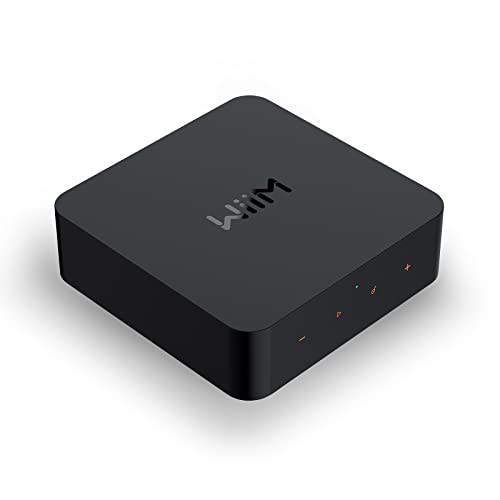
Wiim Pro
Best budget-friendly network music streamer
 Derek Malcolm / Digital Trends
Derek Malcolm / Digital Trends
Wiim Mini
Best bare bones under $100
Pros
- Excellent value for price
- Ultra compact
- Easy setup and use
- Loads of streamer support
Cons
- No native Apple Music support
- DAC is good but not great
Small but mighty is one way to describe the Wiim Mini. Smaller than a hockey puck, and substantially lighter, too, the Wiim Mini has nearly all of the features of its bigger siblings, the Wiim Pro and Wiim Pro Plus for a fraction of the cost. Plus, you can add Minis or other Wiim devices llike the Pro and Plus throughout your house to create a whole-home system.
Much like Sonos, the well-designed Wiim Home app brings everything together for super-easy control. All of your streaming services — from Tidal and Spotify to Qobuz, Amazon Music, Deezer, Pandora, and more (there's no native support for Apple Music, unfortunately) — and a universal search makes finding what you want a breeze. Spotify Connect and Tidal Connect also allow you to not use the Wiim app if you prefer to use their official apps instead. Chromecast, AirPlay 2 and Alexa support lets you group any of those speakers together for multi-room listening, too, and Alexa and Siri compatibility lets you control things with your voice.
Connectivity is pretty basic, though, but it may be all you need. There are 3.5 mm AUX in and out ports for connecting external devices to it as well as connecting it to a receiver/amp or set of powered speakers for playback. Additionally, there's a SPDIF optical out for sending digital audio at up to 24-bit/192 kHz to a compatible device.
Setup and connecting to Wi-Fi couldn't be easier, and the Wiim Mini's DAC sounds great should you opt to not push it through a better one (but you could).

Wiim Mini
Best bare bones under $100
 Digital Trends
Digital Trends
Sonos Port
Best for Sonos users and beyond
Pros
- Works seamlessly with Sonos speakers
- One of the best apps around
- Analog and digital input options
Cons
- Sound could be more expressive
- Expensive
If you've already gotten yourself immersed in the Sonos ecosystem with several Sonos speakers scattered about your home but you still have an additional "dumb" sound system that sounds awesome but is cut off from the Sonos hive, then adding a Sonos Port is an excellent way to bring everything together.
Not only will the Port allow you to access all the same streaming services (including Spotify, Apple Music, Tidal, Qobuz, and more) that you would through the rest of your Sonos speakers on your non-Sonos system, but you can also connect external analog sources such as turntables and CD players to it via RCA for sending out through the system, too. Additionally, the Sonos Port supports Apple AirPlay 2 for sending music directly to it form your iOS devices.
And everything is controlled with Sonos' industry-leading app — there's a universal search feature that will search across all of your signed-in services, and Spotify, Tidal, and Amazon Music users have the option to use those respective apps to control them, should they prefer.

Sonos Port
Best for Sonos users and beyond
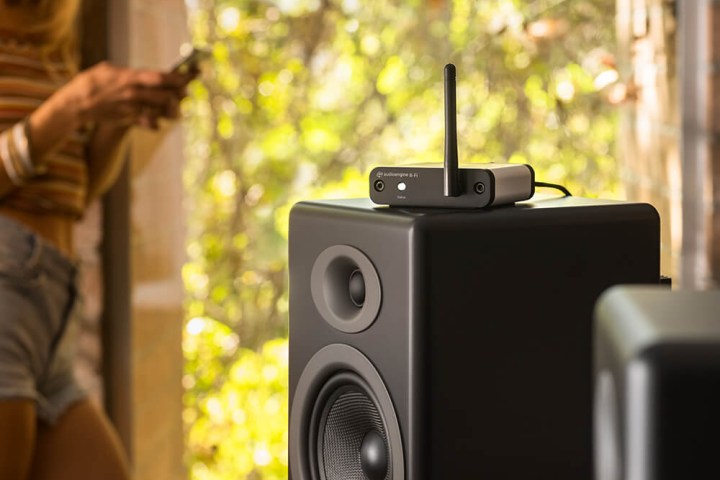 Audioengine
Audioengine
Audioengine B-Fi
Another budget option for beginners
Pros
- Inexpensive
- Super compact
- Easy to set up
- Sounds great for the price
Cons
- Minimal connectivity ports
- Maxes out at 16-bit/44.1kHz
Maybe you’re just getting started with network music streaming, and you’d like a solid and reliable streamer that doesn’t break the bank. If testing the waters before swimming with the manta rays is important, or you just want a great streamer for a great price, the Audioengine B-Fi should more than fit the bill.
Once connected to your Wi-Fi (no Ethernet option on this model), you’ll be able to stream tunes from your iOS devices to the B-Fi using Apple AirPlay and whatever music-streaming platforms you’re subscribed to. Unfortunately, though, there's no Chromecast support, so Android device users are going to have to stick to the Audioengine Control app (iOS and Android), that allows you to control services like Spotify, Tidal, and Qobuz, without having to switch over to another app, even though you can.
You can even use the Control app to link your B-Fi to up to 12 other B-Fi streamers, as well as compatible smartphones, computers, and network storage devices. One thing to note, though, is that the Audioengine B-Fi maxes out at CD-quality 16-bit/44.1kHz resolution, which isn't a bad thing as it still sounds great, but is not considered hi-res lossless that many of the major streaming services are offering.

Audioengine B-Fi
Another budget option for beginners
 Crutchfield
Crutchfield
Bluesound Node (N132)
Has a Bluetooth trick up its sleeve
Pros
- Up to 24-bit/192kHz hi-res support
- Sends and receives aptX Adaptive Bluetooth
- THX AAA headphone amp
- Minimalist design
- Good price
Cons
- No 32-bit support
- Not as advanced as other streamers
Not every network music streamer costs thousands of dollars, and the Bluesound Node (version N132) is proof. Coming in at under $600, the NODE is small enough to fit on just about any shelf or entertainment center. Did you notice the headphone jack on the front of the device? This output is supported by a THX AAA headphone amp, which bodes well for those of us who enjoy hi-res listening through, say, a set of high-quality planar magnetic headphones or other premium over-ears.
The “Bluetooth trick” we alluded to is the Bluesound Node's two-way aptX Adaptive support. Not only will you be able to stream hi-res audio tracks to the streamer from your phone or tablet but you’ll also be able to beam hi-fi tracks from the NODE to a pair of Bluetooth headphones. Beyond its Bluetooth pros, you’ll also be able to stream via AirPlay 2 and from services like Spotify Connect, Tidal Connect, Qobuz, and Pandora, along with built-in support for internet radio stations like TuneIn, iHeartRadio, and SiriusXM.
Flip this puppy around to reveal a massive array of ports, including an HDMI eARC input, analog RCA, digital optical, USB-A, and an Ethernet connection for hardwiring the NODE to your router.
As far as sound quality is concerned, this version of the NODE runs an ES9039Q2M ESS Sabre DAC so that you can expect breathtaking highs, mids, and lows with 24-bit/192kHz playback support and Dolby Digital multichannel audio. That’s on top of an ARM Cortex-A53 quad-core processor for top-shelf network performance.
We also recommend checking out our review of the Bluesound Node Nano.
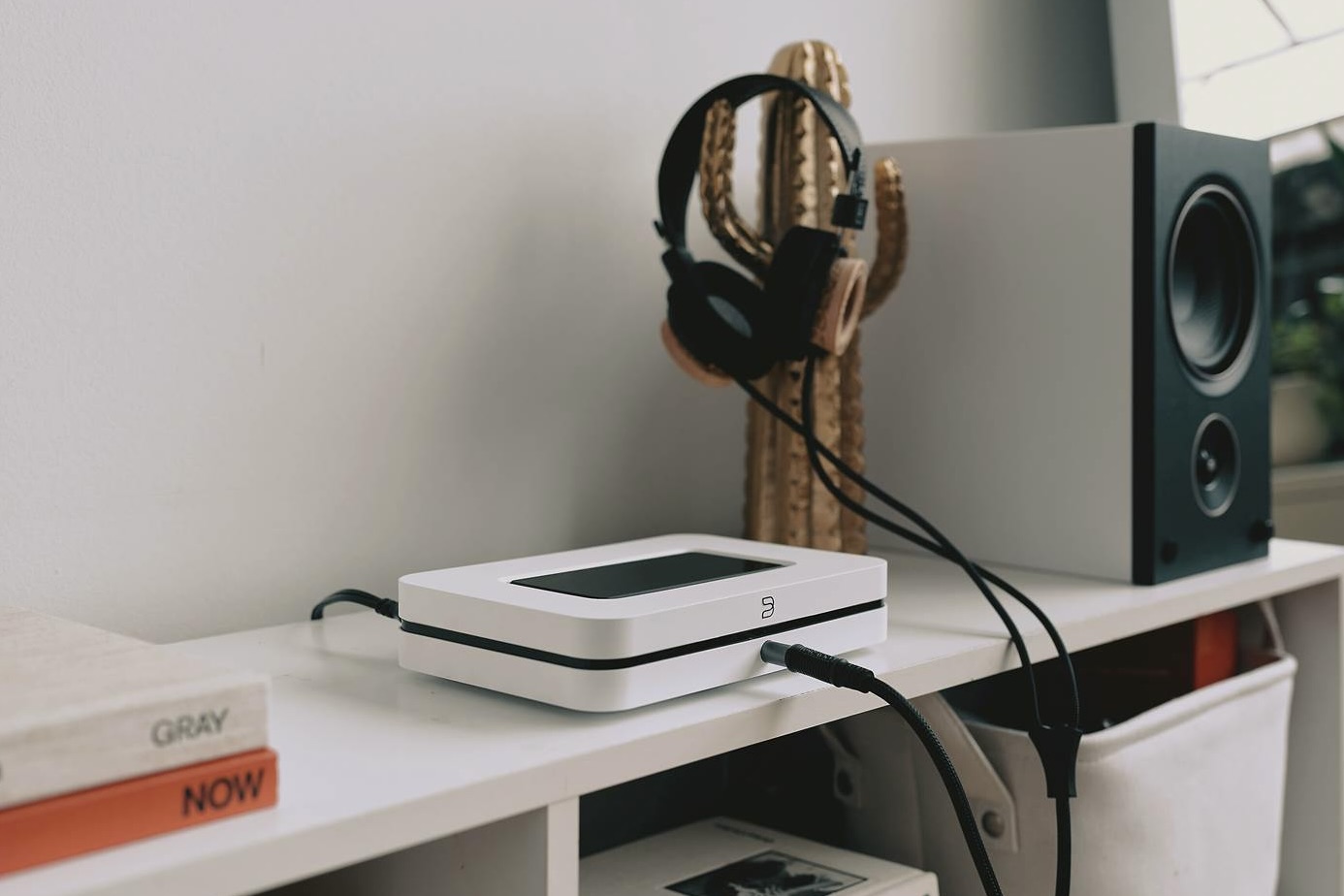
Bluesound Node (N132)
Has a Bluetooth trick up its sleeve



















 English (US) ·
English (US) ·